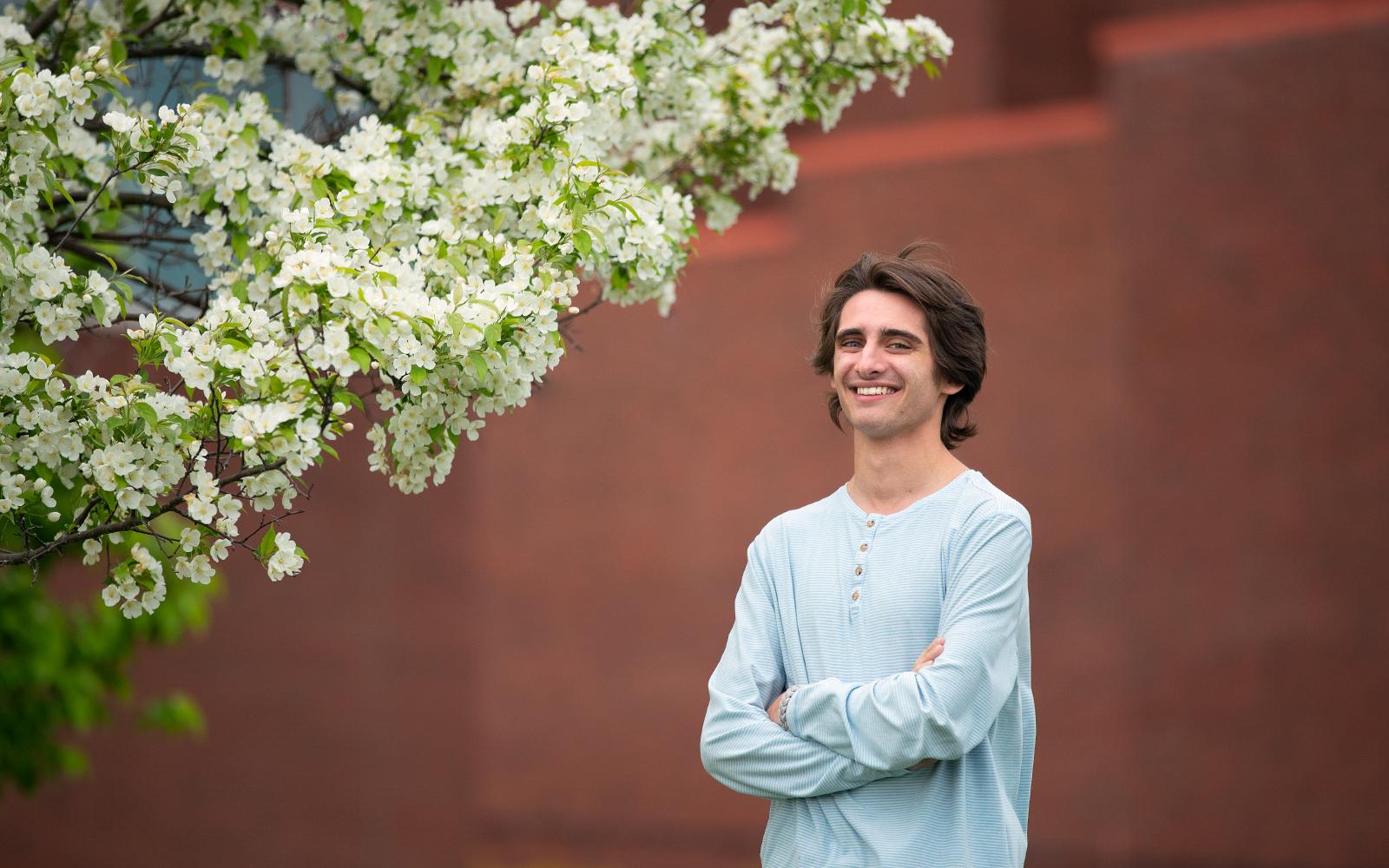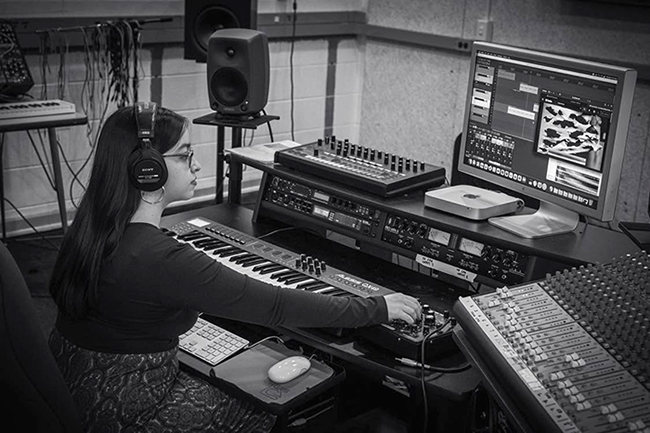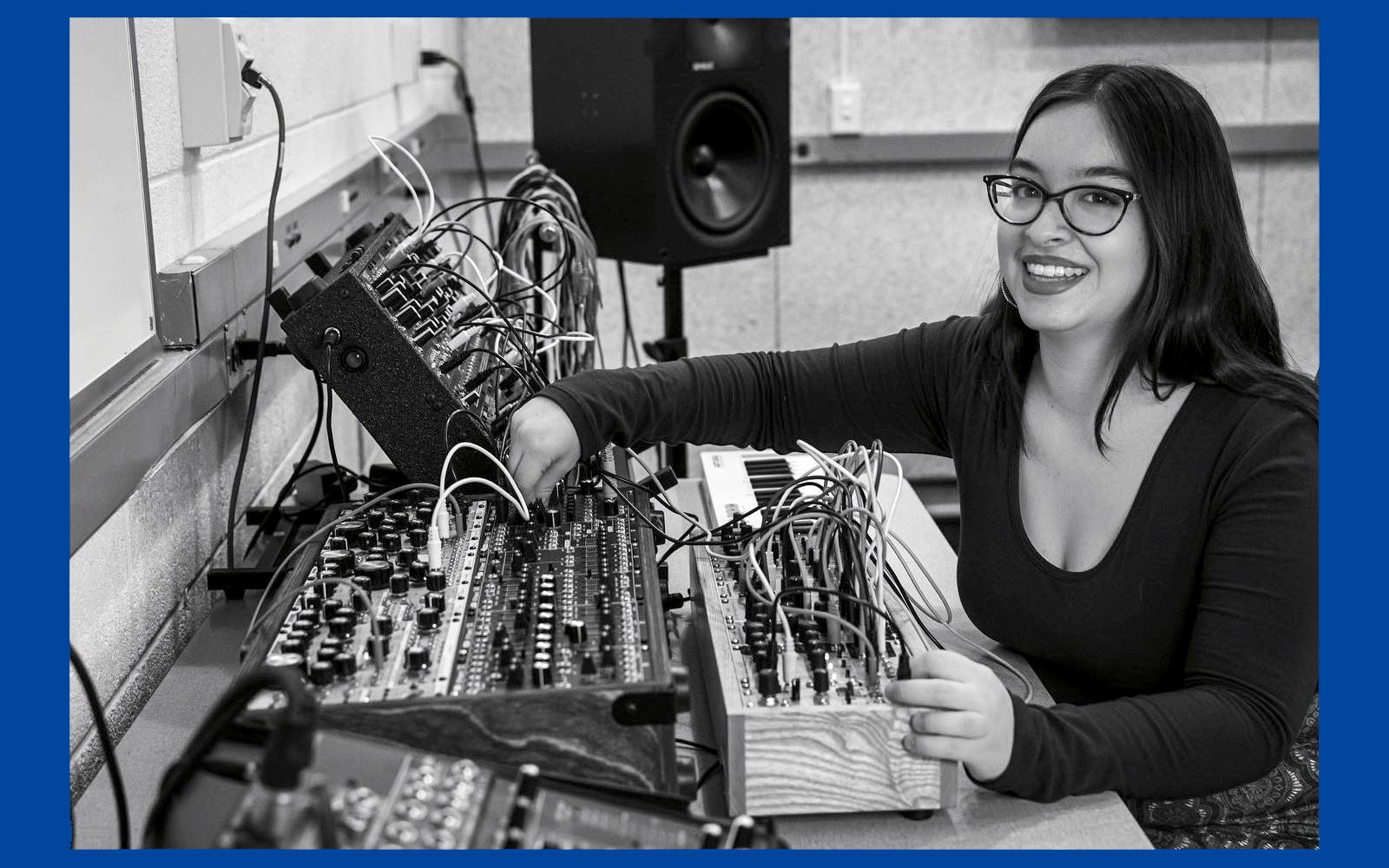In the heart of the Adirondacks, the sound of music intertwines with the sound of nature.
Amplified through a series of 24 speakers selectively placed along a trail winding through the woods at The Wild Center in Tupper Lake, music flows through the air in harmony with the sounds of birds, insects and wind whistling through the pine trees along the Forest Music Trail.
The new music installation, a collaboration between SUNY Potsdam’s Crane School of Music and the Wild Center, features the works of three recent Crane alumni—Katherine McAuliffe ’23, Cole Fortier ’23, and Amanda Rizzo ’22—and blends their original compositions with the sounds of nature at the unique museum located one hour south of SUNY Potsdam.
“It’s all in surround sound, some speakers are on your right side, some on your left, and the trail is in a loop,” said Fortier. “All three of us did our compositions in digital audio workstations, multiple tracks recorded either by ourselves, manipulated by ourselves, or by using found sounds. All our compositions are quite different, which is fascinating.”
The Wild Center’s idea of working with student composers from Crane originated with Rick Godin, a board member at The Wild Center. “We're always looking for new and exciting composers to partner with on installations like Forest Music, and with the reputation that Crane carries, it seemed like a no-brainer,” said Nick Gunn, marketing director for the Wild Center.
“The Crane School of Music is honored to be part of this collaboration, which gave three of our talented student composers the unique opportunity to help shape an unforgettable experience for visitors to The Wild Center.”
Dean of The Crane School of Music
During the Spring 2021 semester, as restrictions were loosening at the tail end of the Covid-19 Pandemic, the three students joined their classmates on a trip to the Wild Center to seek inspiration for the project. “Everything that year had pretty much been online, and so that was one of the first in-person things we did as a group, which was wonderful. We had a little caravan of cars that went down with faculty and students, some of them just going down for the therapeutic experience of being out in nature,” said Fortier.
Inspired by his surroundings, the idea for Fortier’s composition started to take root as soon as he arrived. “The way the light was shining in the forest in May, I kind of heard the music almost immediately, and ran with that. Being down there, through osmosis you kind of assimilate these ideas,” he explained.
In the fall, composition students at Crane presented samples of their work to Dr. Tim Sullivan, Dr. Ivette Herryman Rodriguez, and Dr. Jerod Sommerfeldt, all faculty in Department of Music Theory, History & Composition. “In order to be selected for this project, we had to submit 90 seconds of music that best represented our vision for The Wild Center,” Rizzo said. “I had an idea to write something that sounds meditative but also has elements of whisps and sweeps pan through different outputs. My idea was to create something that sounded as if nature was whispering without words. Upon receiving the email that we were chosen for this project I remember sitting in the living room with my housemates and we were all yelling in excitement together. It was a really great feeling of pride and accomplishment.”
Fortier, McAuliffe and Rizzo were selected for the project, receiving a commission from the Wild Center to complete their unique compositions. Their music is now part of the fabric of the Wild Center experience as visitors walk along the Forest Music Trail. “At first glance, it's an unremarkable patch of forest that is filled with old scotch pines at the end of their lifecycle. But because of the strategically placed speakers, and in the hands of a talented composer, the trail can be transporting. You almost forget you're in the woods and feel like you've been whisked away into a storybook,” said Gunn.

Katherine McAuliffe ’23
For the trio of students, visiting the Wild Center helped inform their creative process. McAuliffe’s “Woodland” was centered around her own vocal performances, while combining different instrumental tracks to supplement the piece. “Everything in my piece was played or sung by myself and recorded in the electronic studio at Crane. I played ukulele, kalimba, little frog uros, rain sticks, and other acoustic wood-sounding instruments that to me gave a timbre of the forest. Having it brought back to nature gets rid of the stress and pressure of a concert hall, a name on a program, and people sitting still for however long and applauding at the end. It gets rid of that formality, so it was a lot more freeing of an experience as a composer and a musician all around,” she said.

Cole Fortier ’23
Fortier’s “Tupper Fantasia,” which features him playing piano, was named after the Adirondack region home to the Wild Center. “That’s the thing that’s interesting about this, you write music knowing that someone could be entering the trail at the beginning of your piece, or toward the end. It’s not like a traditional concert piece where you sit down and listen beginning to end, everyone is essentially experiencing it in a slightly different way. There’s a meditative and emotional quality, and there are deliberate gaps in my piece to allow for a heightened awareness for the listener and the viewer to be more connected to their environment,” he said.

Rizzo, who was completely focused on producing acoustic and ensemble-based music before the pandemic, started working with electronic music during the shift to online learning. When the opportunity arose to compose music for the Wild Center, her newfound genre was the perfect fit. Using a Reaper audio workstation and her MIDI keyboard she composed “Etcher Indwelt” for the Forest Music Trail. “I had so much fun writing this piece. One thing I particularly appreciate about electronic compositions is the idea of creating a world where the listener is drawn into a new soundscape. My main objective was to write something that flows smoothly because it would reflect the tranquility of the landscape,” she said.
In May of 2022, as they were finalizing their compositions and in the process of mixing their music in studio, the trio returned to the Wild Center to make final adjustments before presenting their compositions to the center. In addition to the immersive on-trail experience, the Crane student composers' music can also be purchased in the museum gift shop.
“Truly this is one of the coolest things I've gotten to experience. I remember various nature sounds like woodpeckers and it was really interesting to hear the way that the sounds of nature blend together with the music. Hearing the tracks in different areas of the walk was my favorite part. Each time we did the loop, it was a different way to experience the music.”

On May 18, 2023, the project was unveiled to the public during a reception at The Wild Center where guests could speak with the student composers, and have a chance to saunter along the Forest Music Trail for the immersive experience. Dr. William Gibbons, dean at The Crane School of Music, traveled to Tupper Lake for the event. “Walking the Forest Music Trail creates such a powerful experience—you’re surrounded by the music as well as by the beauty and sounds of nature. The music shapes how you experience the landscape and vice versa, to the point where it’s hard to imagine one without the other,” Gibbons explained.
Gunn reflected on the collaboration with the three composition students, and the impact they had on the Wild Center. “It was a pleasure to work with Kate, Amanda and Cole. To me, composing music for the trail is a total magic trick. It requires the composer to think in three dimensions, which is not easy, but they brought a sense of professionalism and creativity you wouldn't necessarily expect from artists their age. They're total pros and I can't wait to see what they accomplish in their careers.”
Article by Jason Hunter
